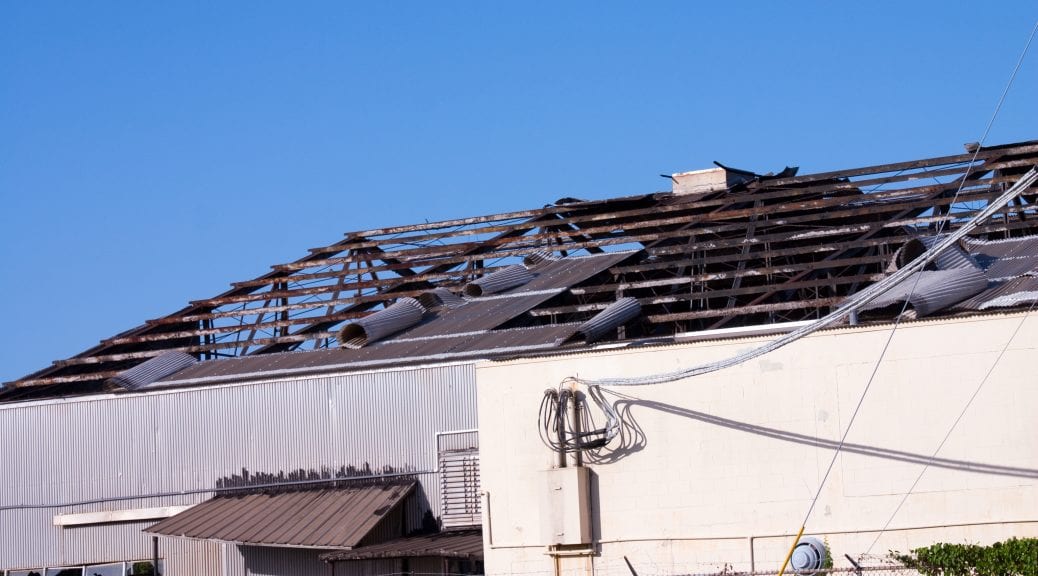When a major storm is in the forecast most people plan accordingly. They might secure loose items around the house or even inspect their roof/shingles to ensure everything looks good. As a business owner, do you put the same consideration into how your commercial roof will fare during inclement weather? Reality is, we can’t control the weather; but we can control how we prepare for it, and that includes making sure that our commercial roofs are able to survive sudden downpours intact.
Discovering storm-damage
Typically, you’ll notice any storm damage the day of or the day following any heavy rain. If you don’t notice it from the outside, you’re more than likely to see signs of it inside. Should your commercial roof show signs of leaking or damage, the first thing you’ll want to do after finding the problem is do your best to mitigate it from within your building. This might include moving products or other objects away from certain areas, or covering them up to protect them from further water damage.
Avoid the temptation to go onto your roof and call a roofing contractor. Roofing contractors will have the proper training and equipment to safely and accurately assess any storm damage for you. In the meantime, you’ll probably be busy contacting your insurance company to inform them about the damage and the need for any repairs you might have to do. But as the owner, your first job is to protect the interior of your commercial building—we’ll take care of the rest.
How to prepare your commercial roof for storms and other inclement weather
The simplest and best thing owners can do for their commercial roofs is follow standard preventative maintenance practices. In the past, we’ve shared best practices for handling preventative maintenance in the spring and in the fall. In particular, you’ll want to perform regular inspections of your roof to ensure it’s cleared of any loose debris and has little or no standing water. Both of these obstacles can increase the likelihood of storm damage or roof problems, so taking the time to keep your commercial roof clear of debris and standing water is a huge part in mitigating future problems.
In most cases, major storm damage will take the form of water intrusion, which comes from too much water at one time and backed up drains. Reduced flow of water can be caused by debris, so it’s important that loose roofing materials, tree limbs or branches, and other similar debris are removed as soon as it’s spotted.
Your best bet will be to enlist the help of a roofing contractor to handle regular inspections for you. They’ll keep you apprised of your roof’s condition and ensure it is weather-ready before the next storm hits.
And remember: even if something doesn’t seem like a problem now, that doesn’t mean a powerful gust of wind or a sudden downpour can’t make it far worse. Caution is preventive, so keep an eye out and note any irregularities in your commercial roof’s performance and let your contractor know as soon as possible.
The most common—and some not so obvious—problems that can develop as a result of storm damage
The most obvious problem you’ll experience with storm damage is leaks. Anything from moisture collecting on the inside of the building to a full-blown leak is possible depending on the current condition of your roof and the severity of the weather. With leaks or actual holes in your roof, you’ll also have to worry about things like bugs, rain, snow, etc. entering your building. Protecting your building, its contents, and those who work inside of it is your first priority after discovering any kind of damage.
We’ve mentioned the importance of clearing your commercial roof of debris already, and that’s because even something like loose flashing or an unsecure piece of rubber could leave you with a gaping hole in your roof if left unchecked under the wrong conditions. If you have noticed debris or loose materials, a contractor can remove these for you and seal things, at least temporarily, until the larger issue can be addressed.
The best way to prevent and reduce storm damage is simply to be aware of your roof and its condition. This is why it’s crucial to pay attention to your commercial roof over time. Small problems can be caught early before they develop into larger or more expensive issues. There’s really nothing you can do against strong winds from worsening something, so the sooner you call a professional to assess your commercial roof’s condition, the better.


